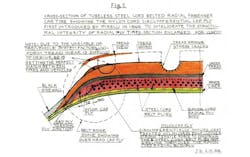First in a series
In January 2002, Modern Tire Dealer published an interview with me titled, “Tires from an engineering perspective.” In that interview I stated the following projects tire manufacturers should undertake in the future:
• tire manufacturing uniformity;
• tire manufacturing precision;
• tire structural integrity retention;
• tire puncture resistance;
• vehicle lifetime tires, perhaps 15 years or 150,000 miles;
• improved/simplified tire replacement and service.
Now, a good 10 years later, MTD asked me if tire manufacturers ever came through, and asked for the status of these developments.
That’s a tall order, in view of the fact that historically, the tire industry has shrouded itself in secrecy and progressed very slowly since the pneumatic tire was first invented by Robert William Thomson, a civil engineer from Middlesex, England, in 1845.
Furthermore, and from my observations, tire and vehicle manufacturers have had recurring difficulties adapting to the tire/vehicle system engineering and development approach, and improving the match between the tires and the vehicles, and this from the tire irregular tread wear standpoint to the overall vehicle tuning, from the NVH (noise/vibration/harshness), traction (braking, accelerating, cornering), handling, rolling resistance, overall operational smoothness and rolling feel standpoints. Some vehicle producers to this day have a tough time perfectly matching tires to their particular vehicles. This is all about having or not having acquired the proper tire/vehicle system development know-how, a very long process, indeed.
From my personal experience, the most significant tire design improvements that I have witnessed have been the advances in tire structural integrity retention by means of improved tire rubber compound/cord composite structures; higher tire manufacturing precision and uniformity; and, last but not least, after many years, the now generally adopted Pirelli “nylon cord bandage” or “cap-ply” architecture.
And here is why: From the dawn of the radialization in France in 1949, the initial structural integrity and operating smoothness retention of the radial-ply tire was of major concern to tire designers. It was also of major concern to tire retreaders, for without good structural integrity retention, the passenger car radial-ply tire could not be successfully retreaded.
[PAGEBREAK]
Prior to the introduction of the Pirelli CN36 nylon bandage/cap ply in 1969, belt/tread detachments or separations were the most common durability failure mode of the steel cord-belted tubeless radial passenger car tires. This failure mode was due to the effects of a combination of tire design adverse factors on which I shall not elaborate, but which, I can assure you, were well-known to tire designers throughout the world and to me.
I first noticed this typical failure mode while working on tire/vehicle systems at Ford Motor Co. in the early 1960s. Back then, vehicle manufacturers did not really develop vehicle dynamics in consideration of possible radial tire belt/tread detachments or separations. But I was curious and, therefore, I focused on them, including using the tire retreading process to make the point. I concluded at the time that tire belt/tread detachments were, indeed, a serious matter, and I immediately called it to the attention of all the radial-ply tire manufacturers.
At the beginning of the U.S. radialization, most tire producers did not readily recognize the significance of the Pirelli CN36 nylon cord bandage/cap-ply tire, but after a few years of operation under real world road/tire/vehicle system operation, they finally did, since radial-ply tires with the Pirelli CN36 design feature experienced much less tread/belt separations, and were working more coherently, as they should.
The cap-ply tires also contributed to improved vehicle handling, as well as to some aspects of the overall vehicle operating smoothness characteristics, this, however, depending upon the degree of thoroughness achieved by vehicle and tire producers in regards to tire/vehicle system tuning. Tuning is the perfect matching of tires to a vehicle and vice-versa.
The Pirelli CN36 in a nutshell
What is the Pirelli CN36 nylon cord banded/cap-ply tire?
In a nutshell, the 1969 Pirelli CN36 steel cord-belted tubeless rayon cord radial body passenger car tire featured a nylon cord cap ply. The purpose of this cap ply was to “girdle” the tire rayon cord radial body and its two steel cord belt plies underneath the tread. This was achieved by winding circumferentially, and under slight tension, heat-treated nylon cords during the green tire assembling process, and this over the entire width of the tire’s two steel cord belt ply package, plus about 10mm over both steel cord belt edges, and connecting to the radial body ply, as shown on Figure 1. This improved tire structural integrity by preventing the steel cord belts from separating from the tire radial body.
The Pirelli CN36 nylon cord cap ply was, in a way, the effective application of what I then called “the containment theory”: It effectively kept the tire’s steel cord belt and tread package in place throughout the life of the tire tread.
The improvement in tire structural integrity retention soon became evident. Also evident was a certain amelioration in overall vehicle operating smoothness and rolling feel characteristics, steering and braking included. The fact that nylon is a material that shrinks when subjected to elevated temperatures further assisted the tire’s nylon cord bandage to keep the steel cord belt in place underneath the tread. It was, no doubt, a brilliant idea that was needed to solve a basic problem, and for which Pirelli should be given full credit.
Figure 2 shows a sketch of a cross-section of a radial passenger car tire without the Pirelli nylon cord bandage or cap ply feature. This sketch was part of an article I wrote for the June 2008 issue of MTD on the subject of tire structural integrity. Note the typical steel cord-belted radial tubeless tire belt edge failure mechanism, starting with 1) socketing, 2) cracking, and 3) separation and propagation within the tire’s steel cord belt s
[PAGEBREAK]
Reminiscing
Over the last 40 some years, significant changes have occurred in vehicle architecture, particularly the switch from body-on-frame to unitized-body construction, and to front-wheel and four-wheel drive powertrains. This has resulted in more difficult and more expensive tire/vehicle system tuning, particularly from the NVH standpoints.
Years ago, vibrations from slightly out-of-balance tire/wheel, brake rotor or drum assemblies as well as vibrations from tire/wheel assembly radial, lateral and tangential force variation situations were better absorbed by rear-wheel drive vehicles featuring body-on-frame architectures, and by suspensions having a sufficient amount of fore and aft compliance, as well as by tires (bias or radial) of much higher section height to width ratio, such as .78, .80, mounted on 13-, 14 – and 15-inch diameter wheels with rim width dimensions not exceeding 70% of the inflated tire section width. These tire/wheel assemblies used wheels made of steel, which were lighter as compared to the 18-, 19 – and 20-inch and above diameter wheels made of cast aluminum, such as used on many vehicles today.
Back then, vehicle powertrains, (engine, transmission, axle) were also better insulated, suspension bushings were softer, as were the body mounts, and all this contributed to a smoother-running vehicle. These were the days when the American automobile was the world standard in ride, operating smoothness and intuitive operating characteristics. Few consumers ever complained about vehicle handling or directional stability. Some tell me that cars today handle better. What they really mean is that they handle more quickly. But does that mean better?
Years ago when I worked at Ford, a special testing program was set up to evaluate the vehicle evaluators. It created quite a furor, but the program soon exposed that some evaluators, on a blind-test basis, were not as good as they could have been, and did not consistently represent the consumer’s point of view or have the consumer’s best interest in mind. But for those with a high level of scientific integrity, one thing was certain: Vehicle quietness, smoothness, good rolling feel, low harshness level and overall vehicle handling predictability were the most important vehicle performance acceptance criteria.
All in all, however, it was the improvement in the radial-ply tire structural integrity that made the day. Even today, when I look at scrap tires, I still see some evidence of the radial tire’s typical failure mode, but as compared to the pre-cap ply era, the magnitude of the problem has been dramatically reduced, for every radial-ply tire producer selling tires to the modern world today has incorporated the nylon bandage cap ply, including on radial tires for Class 8 over-the-highway trucks, earth movers, etc. So, I repeat, that of all the developments throughout the radialization, the Pirelli nylon cord bandage or cap ply is by far the most significant of all.
[PAGEBREAK]
MTD’s questions from 10 years ago
To answer MTD’s question if the tire manufacturers ever came through on my original suggestions of 10 years ago, the answer is that some of the projects I recommended to undertake at the time were already underway, and this as part of a continuous improvement philosophy.
In some instances this was insufficient, and therefore, as the years went by, some deviations from perfection unfortunately developed. So, have the tire producers fulfilled the expectations I outlined 10 years ago? My answer: not entirely, for today, many consumers are seriously economically challenged, and they complain not only about tire prices being excessively high, but also about tire mileage at times being excessively low (25,000 to 30,000 miles), and that some tires develop uneven tread wear.
The pneumatic tire today can be considered a mature, fully developed product which, in my opinion, will no doubt continue in its present form into the foreseeable future. More efforts, however, need to be devoted to improving the tire fatigue and aging resistance, as well as its resistance to punctures.
Furthermore, I personally believe that the future lies in dramatically reducing the complexity of the tire manufacturing process, including taking another look at the “two shot/two material” tire design and manufacturing system making use of the liquid reaction injection molding system which, if correctly implemented, should contribute to improving the precision with which tires can be manufactured, as well as other aspects of tire performance.
But perhaps of even greater importance in the future will be improving the match between tires and vehicles. To do that will require a higher level of cooperation between vehicle and tire/wheel producers, which lately have given me the impression that they tend to do just the minimum required to meet current standards and regulations. Tire and vehicle producers should also concentrate more of their development efforts on technologically based objectives rather than on the cosmetic aspects of tire/wheel assemblies, as exemplified by the relatively recent plus-sizing movement, a highly unproductive endeavor which is unnecessarily costly to consumers.
Contemplating the last 56 years since Robert McNamara instructed us at Ford to equip our cars with tires capable of providing a minimum of 50,000 miles of service, which then only radial tires could do, I still feel that the tire industry could and should do more to reach this objective. For a tire to consistently provide such mileage, it must be designed and developed to deliver 75,000 miles.
At one point I thought that the industry was on its way to reach such objective, but unfortunately that did not last, and mileage actually decreased. Knowing the radial-ply tire’s potential for long life and mileage, and having been instrumental in introducing the radial tire in North America, I, until recently, felt quite disappointed that the tire manufacturers as a whole did not do a better job of fulfilling that potential, thereby depriving the consumer of such benefit. In a speech I gave at a conference in 2004 I mentioned “it remains to be seen if consumers will accept radial-ply tires providing bias tire mileage at radial-ply tire prices.” I might add to this that the tire industry wouldn’t dare do that to heavy-duty radial truck tires.
Pass or fail?
To sum it all up, I gave the industry a passing grade, with some exceptions, in regards to improving the passenger car tire manufacturing precision and uniformity over the last 10 years. As for improving structural integrity retention, progress has no doubt been achieved, particularly since the general adoption of the Pirelli cap ply. I cannot, however, say the same for improvements in tire puncture resistance.
[PAGEBREAK]
I would have given the industry a failing grade in regard to providing consumers with long life tires across all tire lines, had it not been for the recent introduction by some tire manufacturers of 75,000 — to 90,000-mile radial passenger car tires. Only tires of .70 aspect ratio or above have the potential to deliver such mileage. It remains to be seen, however, if these tires can actually deliver 100% of their warranted mileage.
Regarding vehicle lifetime tires, perhaps 15 years or 150,000 miles, the industry today is far from reaching such an objective. To do so would require a complete reassessment of tire/wheel system design, as well as the development of new tire materials and processes. This, I do believe, can eventually be achieved. If, as an interim solution, 75,000-mile radial passenger car tires could be successfully retreaded for another 75,000 miles of service, the 150,000 mile tire casing life could become a reality. Since the retail purchase price of a retreaded tire usually is one-half that of a new tire, it would, at tire replacement time, also relieve the consumer of sticker shock.
As for simplifying passenger car tire replacement and service, I give the industry a failing grade. Much more needs to be done. Every tire is different, and every tire/vehicle combination or system is different, but, is the consumer sufficiently aware of these differences, as well as sufficiently knowledgeable to make an informed purchasing decision at tire replacement time?
So much for improvements and progress over the past 10 years. But I am not giving up on the American ingenuity and spirit, and I am eagerly looking forward to what the next 10 years will bring. I hope that you do, too.
To the tire industry worldwide I say: Surprise us! ■
Pirelli leads the pack
Pirelli & Cie SpA put its patented CN36 radial-ply tire, which featured the nylon cap ply, in production in 1969. It took the rest of the tire industry over 30 years to incorporate cap plies in their own tires. Why the delay? I don’t know, perhaps to avoid paying licensing fees.
The cap ply, I feel, was the savior of the steel cord-belted, radial-ply tire from the structural integrity retention standpoint.
Isn’t it strange that the original Michelin steel cord-belted, radial-ply tire ended up relying on a nylon cord containment system to keep the steel cord belt in place? — Jacques Bajer
About the author
Mechanical engineers are, by their very nature, problem solvers. Whether they invent, redesign or trouble shoot, their purpose is to take mechanical principles and apply them to machines or tools. The result, if successful, can be mundane, evolutionary or revolutionary.
In our industry, Jacques Bajer is best known not only for his pioneering work with Ford Motor Co., but also for championing America’s conversion from bias-ply to radial-ply tires.
His influence was revolutionary — the need to keep the tire-vehicle system in mind when designing tires has led to vastly superior tire and vehicle performance.
We have all benefited from his efforts.
Here’s what Modern Tire Dealer wrote about Bajer 47 years ago when Ford offered the “new” radial tire as optional equipment on several 1966 compacts: “The debut of this tire, which is likely to have important repercussions in Washington and at the other auto companies, represents the crowning achievement for Jacques Bajer, Ford’s talented advanced tire development engineer.”
Bajer remains active in our industry, as both president of Tire Systems Engineering Inc., and a contributor to MTD.




